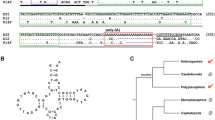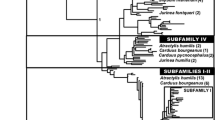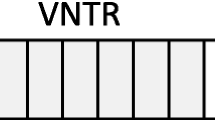Summary
Comparative analysis of the available 3′-portions of the human L1 (LINE-1) family of repeated sequences indicates that all the sequences can be classified in two major subfamilies. The division is based on patterns of diagnostic bases shared within L1 subfamilies of sequences but differing between them. The overall ratio of replacement to synonymous positions, occupied by the diagnostic bases in the large open reading frame of the L1 sequence, is 1.15. This indicates that both subfamilies were obtained from genes coding for functional proteins. The L1 subfamilies appear to be of different ages and may represent a “fossil record” of the same active gene at different times in the history of primates. The younger subfamily can be split further into at least two closely related branches of sequences. The above facts combined with the recent data for the Alu subfamily structure show that LINE and SINE families of interspersed repeats share discontinuous patterns in their evolution. These data are consistent with the model that both Alu and L1 families, as well as other pseudogene families, contain active genes producing discrete layers of pseudogenes throughout the history of primates. Models of evolutionary processes that could generate these discontinuities are discussed together with the possible biological role of Alu and L1 genes.
Similar content being viewed by others
References
Britten RJ, Baron WF, Stout D, Davidson EH (1988) Sources and evolution of humanAlu repeated sequences. Proc Natl Acad Sci USA 85:4770–4774
Daniels GR, Deininger PL (1985) Repeat sequence families derived from mammalian tRNA genes. Nature 317:819–822
Deininger PL, Daniels GR (1986) The recent evolution of mammalian repetitive DNA elements. Trends Genet 2:76–80
Evans MJ, Scarpulla C (1988) The human somatic cytochrome gene: two classes of processed pseudogenes demarcate a period of rapid molecular evolution. Proc Natl Acad Sci USA 85: 9625–9629
Fanning T, Singer M (1987) The LINE-1 DNA sequences in four mammalian orders predict proteins that conserve homologies to retroviral proteins. Nucleic Acids Res 15:2251–2260
Faulkner DV, Jurkan J (1988) Multiple aligned sequence editor (MASE). Trends Biochem Sci 13: 321–322
Hardies SC, Martin SL, Voliva CF, Hutchison CA III, Edgell MH (1986) An analysis of replacement and synonymous changes in the rodent L1 repeat family. Mol Biol Evol 3:109–125
Hardman N (1986) Structure and function of repetitive DNA in eukaryotes. Biochem J 234:1–11
Hattori M, Kuhara S, Takenaka O, Sakaki Y (1986) L1 family of repetitive DNA sequences in primates may be derived from a sequence encoding a reverse transcriptase-related protein. Nature 321:625–628
Jagadeeswaran P, Forget BG, Weissman SM (1981) Short interspersed repetitive DNA elements in eucaryotes: transposable DNA elements generated by reverse transcription of RNA pol III transcripts?. Cell 26:141–142
Jurka J, Smith T (1988) A fundamental division in theAlu family of repeated sequences. Proc Natl Acad Sci USA 85: 4775–4778
Kazazian HH Jr, Wong C, Youssoufian H, Scott AF, Philips DG, Atonarakis SE (1988) Haemophilia A resulting fromde novo insertion of L1 sequences represents a novel mechanism for mutation in man. Nature 332:164–166
Loeb DD, Padgett RW, Hardies SC, Shehee WR, Comer MB, Edgell MH, Hutchison CA III (1986) The sequence of a large L1Md element reveals a tandemly repeated 5′-end and several features found in retrotransposons. Mol Cell Biol 6: 168–182
Martin SL, Voliva CF, Burton FH, Edgell MH, Hutchison CA III (1984) A large interspersed repeat found in mouse DNA contains a long open reading frame that evolves as if it encodes a protein. Proc Natl Acad Sci USA 81:2308–2312
Milosavljevic A, Haussler D, Jurka J (1989) Informed parsimonious inference of prototypical genetic sequences. Proceedings of the Second Workshop on Computational Learning Theory. Morgan Kauffmann, Menlo Park, CA
Mottez EP, Rogan PK, Manuelidis L (1986) Conservation in the 5′-region of the long interspersed mouse L1 repeat: implications of comparative sequence analysis. Nucleic Acids Res 14:3119–3136
Quentin Y (1988) TheAlu family developed through successive waves of fixation closely connected with primate lineage history. J Mol Evol 27:194–202
Rogers J (1985) The origin and evolution of retroposons. Int Rev Cytol 93: 187–279
Sakaki Y, Kurata Y, Miyake T, Saigi K (1983) Two-dimensional gel electrophoretic analysis of theHindIII 1.8-kb repetitive-sequence family in the human genome. Gene 24:179–190
Sakamoto K, Okada N (1985) Rodent type 2 Alu family, rat identifier sequence, rabbit C family, and bovine or goat 73-bp repeat may have evolved from tRNA genes. J Mol Evol 22:134–140
Scott AF, Schmeckpeper BJ, Abdelrazik M, Comey CT, O’Hara B, Rossiter JP, Cooley T, Health P, Smith KD, Margolet L (1987) Origin of the human L1 elements: proposed progenitor genes deduced from a consensus DNA sequence. Genomics 1:113–125
Servomaa K, Rytomaa T (1988) Suicidal death of rat chloroleukemia cells by activation of the long interspersed repetitive DNA element (L1Rn). Cell Tissue Kinet 21:33–43
Singer MF (1982) Highly repeated sequences in mammalian genomes. Int Rev Cytol 76:67–112
Singer MF, Skowronski J (1985) Making sense out of LINES. Trends Biochem Sci 10:119–122
Skowronski J, Singer MF (1986) The abundant LINE-1 family of repeated DNA sequences in mammals: genes and pseudogenes. Cold Spring Harbor Symp Quant Biol 51:457–463
Skowronski J, Fanning TG, Singer MF (1988) Unit-length line-1 transcripts in human teratocarcinoma cells. Mol Cell Biol 8: 1385–1397
Slagel V, Flemington E, Traina-Dorge V, Bradshaw H, Deininger P (1987) Clustering and subfamily relationships of theAlu family in the human genome. Mol Biol Evol 4:19–29
Smith TF, Waterman MS (1981) Identification of common molecular subsequences. J Mol Biol 145:195–197
Sobel E, Martinez HN (1985) A multiple sequence alignment program. Nucleic Acids Res 14:363–374
Ullu E, Tschudi C (1984) Alu sequences are processed 7SL RNA genes. Nature 312:171–172
Ullu E, Weiner AM (1985) Upstream sequences modulate the internal promoter of the human 7SL RNA gene. Nature 318: 371–374
Van Arsdell SW, Denison RA, Bernstein LB, Weiner AM, Manser T, Gesteland RF (1981) Direct repeats flank three small nuclear RNA pseudogenes in the human genome. Cell 26: 11–17
Wagner M (1986) A consideration of the origin of processed pseudogenes. Trends Genet 2:134–137
Weiner AM, Deininger PL, Efstradiatis A (1986) Nonviral retroposons: genes, pseudogenes, and transposable elements generated by the reverse flow of genetic information. Annu Rev Biochem 55: 631–661
Wilbur WJ, Lipman DJ (1983) Rapid similarity searches of nucleic acid and protein data bases. Proc Natl Acad Sci USA 80:726–730
Wilde CD (1986) Pseudogenes. CRC Crit Rev Biochem 19: 323–352
Willard C, Nguyen HT, Schmid CW (1987) Existence of at least three distinctAlu subfamilies. J Mol Evol 26:180–186
Author information
Authors and Affiliations
Rights and permissions
About this article
Cite this article
Jurka, J. Subfamily structure and evolution of the human L1 family of repetive sequences. J Mol Evol 29, 496–503 (1989). https://doi.org/10.1007/BF02602921
Received:
Accepted:
Issue Date:
DOI: https://doi.org/10.1007/BF02602921




